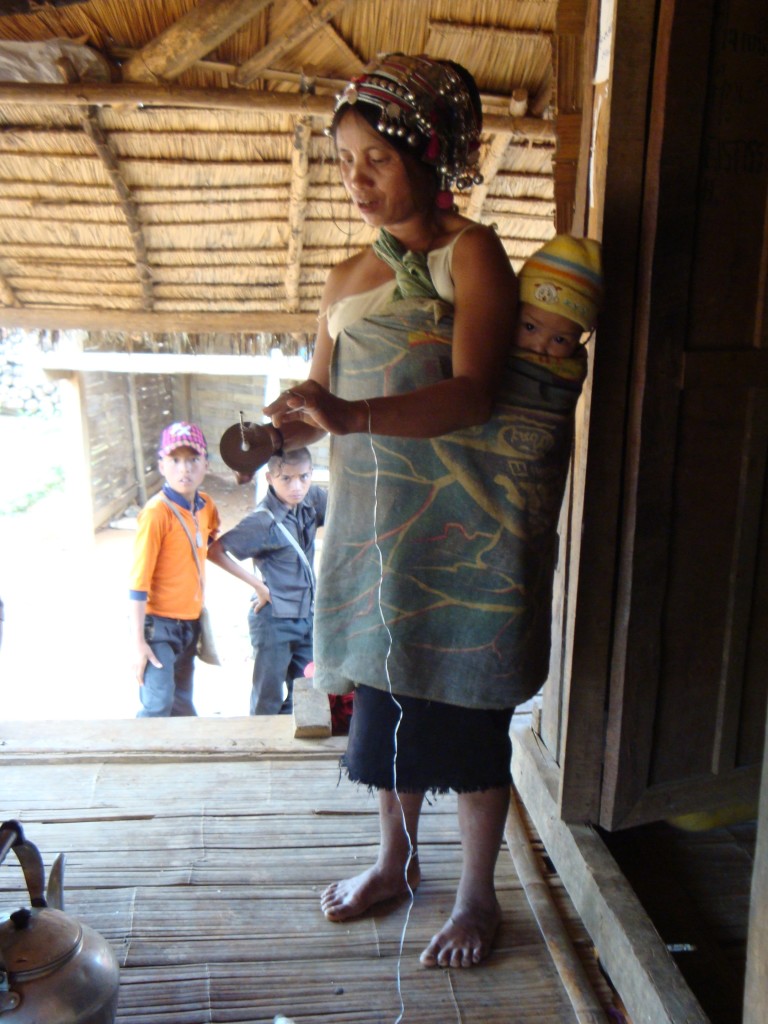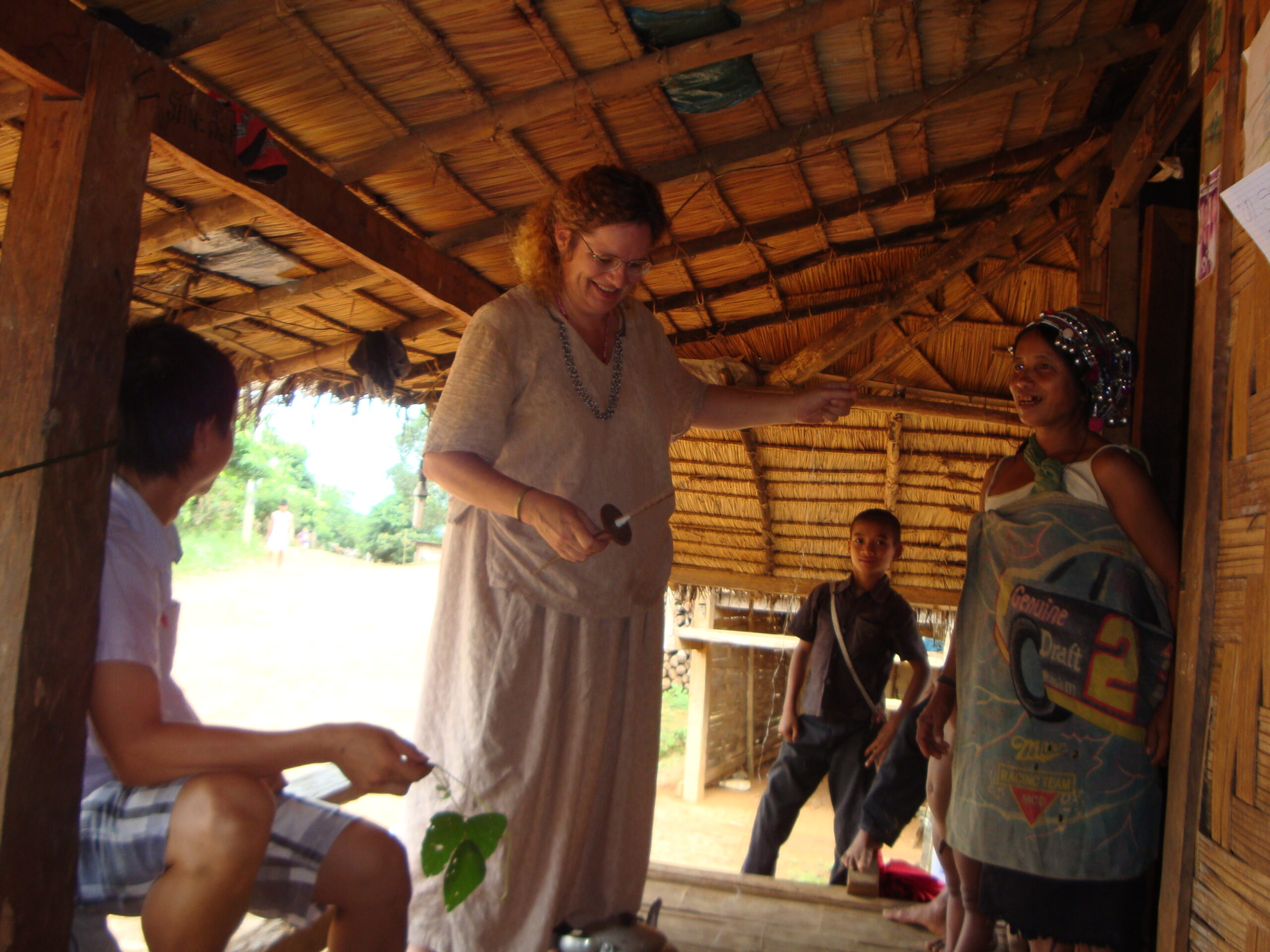The muddy path was literally steaming. The brief monsoon downpour had been followed by the re-emergence of the close, tropical sun, and all three of us – Maren, our local guide Tui, and I – wiped our brows as we trudged up the hill to the small Akha-Puli village. It was only a one-kilometer walk from the sealed road, but the slippery path and inescapable humidity were quickly wearing us down.
We rounded one last corner and welcomed the sight of the first thatched-roof homes of the village. Tui smiled and waved to a woman sitting on the bamboo porch of the first home. As we approached, Tui greeted her: “Udu-tamah.” She squinted and then smiled at the unusual sight of two 50-something westerners negotiating the slick slope in their flip-flops and a non-Akha guide speaking Akha (albeit, Tui admits, with a heavy accent). We could see she had a wooden spindle in her hands, but she laid it down as we approached.
The woman wore her traditional silver-decorated headdress and a well-worn, handspun, indigo-dyed cotton skirt. A commercial acrylic scarf wrapped over her shoulder and around her back to hold an infant.
She excused herself for a moment, disappeared into her home, and re-emerged wearing a sleeveless factory-made spaghetti-strap shirt to cover her bare chest. She swung the small child around onto her back again and wrapped a printed towel around the both of them. We sat in silence for a few moments catching our breath. We smiled and nodded toward the spindle, encouraging her to continue with her work. She pointed one hand at Maren and the other at me and then placed her hands together, inquiring if we were “together.” We confirmed we were a couple and had two sons, now grown. Through Tui, we learned that she had 6 children, two boys and four girls, the youngest of whom was on her back. We told her we were Americans visiting the beauty of their village and that we were enthusiasts about traditional textiles. She nodded with every careful word Tui translated.
She adjusted her headdress and picked up the thin, wooden center-whorl spindle she had earlier set aside. With her left fingers, she stretched the white fiber she was working with up and away from her standing body. She adjusted the floss-like material between the fingers of her right hand, and then hooked it onto a notch cut into the top of the spindle. With her right hand, she pressed the pencil-thin spindle against her skirt with her palm and rolled the spindle downward against her thigh; the elegant spindle dropped and danced an inch from the ground in perfect vertical balance, twisting the fiber suspended from her left hand. After a few seconds of spin, she reached down and grabbed the spindle with her right fingers, one finger deftly knocking the fiber out of the notch and then manually wound the new-spun material onto the spindle.
Seamlessly, the woman reached down with her left hand and grabbed another strand of material. With her right, she split the now-spun material with her fingernail, making an “eye-hole” about two inches from the fiber’s end. The new strip slipped precisely through the hole. With her right thumb and forefinger, and using a quick one-two motion, she rubbed the new material and the right side of the eyehole together and then reversed the spin, winding the half-strip and the full new strip back over the left side of the original thread. The material was spliced tightly. She pulled the clingy new length out and away from her body, and then repeated the leg rub, the drop of the spindle, and the tidy wrap.
Our eyes wandered to the source of this white fiber: it appeared to be coming out of a stained 50-kilo plastic rice bag that lay on the bamboo-slat decking. Maren reached down to open the bag.
She stopped, then smiled. The fiber, indeed, was the bag, and she was expertly spinning the 3 foot (1 m) long fiberglass threads. Maren laughed. The woman nodded and laughed with her.
”What are you making?” we asked through Tui. The two exchanged words, and then Tui turned to us.
“She is making a carrying bag.” And, of course, we had a flood of other questions. Yes, they still spun cotton, when it was in season, but not as much as before. Pre-made clothing was readily and cheaply available, as evidenced by her knit shirt and the children’s commercially-made clothing. But yes, her own skirt was spun and then woven of locally-grown cotton that had been indigo-dyed.
A few years ago, she explained, she would have used the wild-grown piat vine as material for this current project, but it took a long time to find, strip and splice the wild vine before then hand-knotting its threads into a purse. These “pre-shaped” plastic strips were free, available … and even waterproof! She reached into a plastic bag set on the ground and handed Maren a ball of expertly-spun fiberglass stripping.
The woman proudly stepped forward and handed Maren the spindle. She said some words, which we assumed meant: “It’s your turn.”
To the delight of the family, Tui and the growing group of curious children, Maren spent the next few minutes learning the fine art of spinning and splicing fiberglass the Akha-Puli way. Everyone laughed at her initial awkwardness – Maren most of all – but the woman patiently helped her with splicing the fiber, rolling the spindle against her leg to get the quick spin, and then letting the spindle fall and twirl at just the right height. A moment’s pause – then the quick hand-winding to a tidy bundle. Everyone cheered when success was finally achieved, and Maren took a formal bow.
The woman reached up and grabbed Maren’s shoulder and laughed an outpouring of words. Tui smiled: “She says now you are an Akha woman!” And we all laughed again.





